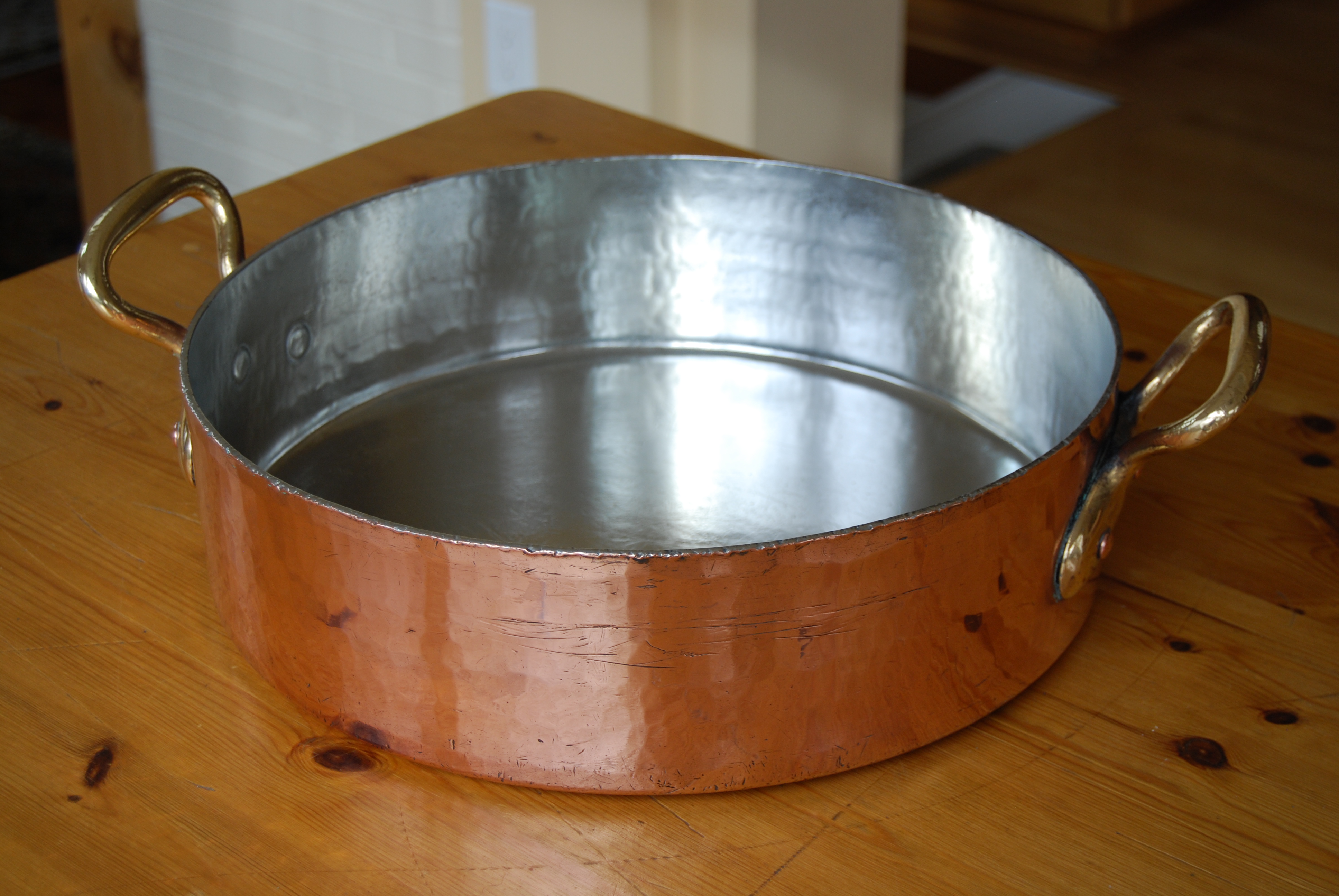This gorgeous rondeau traveled the glamorous railways of Europe.

- Type: Tin-lined rondeau in hammered finish with brass handles fitted with three copper rivets
- French description: Rondeau étamé et martelé avec poignées en laiton munies de trois rivets en cuivre
- Dimensions: 38cm diameter by 11cm tall (15 inches by 4.3 inches)
- Thickness: 3.8mm at rim
- Weight: 8174g (18 lbs)
- Stampings: “LEFEVRE VILLEDIEU”; “WL”
- Maker and age estimate: Lefèvre Frères; 1900-1920s?
- Source: FrenchAntiquity
I love me a good rondeau and this is a spectacular one. A rondeau is essentially a sauté pan with two loop handles instead of a long stick handle. This configuration exchanges one use for another: you can’t really jump food in a rondeau as you would with a long-handled sauté, but on the other hand, you can easily slide a rondeau into the oven without worrying about how a projecting handle would fit. For stovetop work where you don’t expect to jump food, a rondeau is just as good as a sauté, and is a little more compact if you’re managing work across multiple hobs.
All of this is to say that I have several rondeaux in various sizes to which this one is a nice addition. At 38 centimeters (15 inches) and 18 pounds it’s a hefty piece, but the two-handled configuration makes it much more manageable than a stick-handled sauté of the same diameter. That efficient design likely came in handy for the pan’s work in the railcar kitchens of the Compagnie International des Wagons-Lits that traveled across Europe.
It’s also beautiful.

This is a piece that has seen a lot of work in a kitchen. It is battle-scarred, which should come as no surprise given its service on a busy and cramped kitchen. It has been slid between other objects that have left their marks on its flanks.

The floor of the pan also has many pits and scratches from use. Tin is not like spackle in that it cannot camouflage gouges and deep scratches like this. However, in a piece such as this one that approaches 4mm in thickness, these are but minor surface imperfections — scars from faithful service that do not threaten the pan’s integrity.

On this, as on other large copper pieces I’ve seen, there are lots of scrapes and dings at the rim.

The handles are large brass fittings about 14cm (5.5 inches) across at the baseplate. One of the handles has torqued slightly. I’ve seen this on other heavy pieces as well. The brass seems to bend before the rivets deform; perhaps the heavy baseplate helps to spread the mechanical stress.


The interior rivets are hammered flat but not totally flush to the interior surface.

The underside is beautifully hammered. There are scratch marks around the perimeter as is common with big heavy pieces like this, but the surface of the base retains its hammered finish.

This rondeau carries the initials “W L” for its owner, Wagons-Lits, and the stamp of Lefèvre Villedieu. This is a smaller and less ornate version of the Lefèvre stamp and I suspect it is a 20th century version.

This pot traveled across Europe doing hard service in a traveling kitchen. From 1874 to the 1960s, Wagons-Lits carried travelers from France to Moscow, St. Petersburg, Portugal, Madrid, Cairo, Athens, Istanbul, Baghdad, Bucharest, and more, including the famous Orient Express.


Lefèvre is more of a mystery. I have spent some time poking around the Internet and there is precious little out there, but I do know that Lefèvre Frères was a chaudronnerie in Villedieu-les-Poêles around 1900. (Note that in the advertisement below, poêles is spelled with an umlaut ë instead of the usual circumflex ê.)
I can’t find much more about Lefèvre during the 20th century. In 1975, the company hired Étienne Dulin to manage the enterprise, and in 1980, Maurice Lefèvre sold the firm to him outright. Dulin reformed the company as Atelier du Cuivre and by 1985 had opened up the shop to visitors, apparently one of the first copper workshops in France that was open to the public. If you ever have the opportunity to visit the Atelier in Villedieu-les-Poêles, know that its history extends back into the 19th century.






